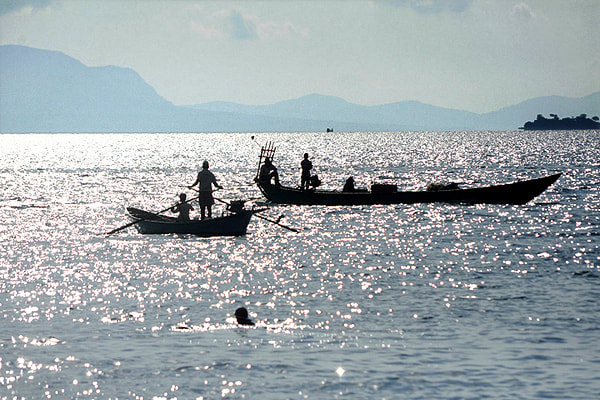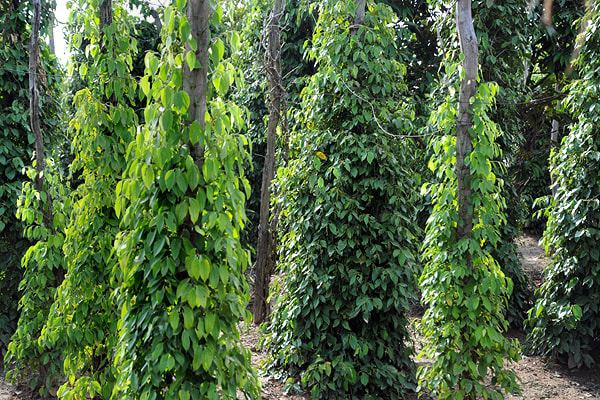Kep is Cambodia's second most important seaside resort. It is also called Kep-del-Mer, Krong Kep or Kaeb. The Khmer name means "Horse-Saddle". Kep is the capital of Cambodia's smallest province. Kep province was founded 2008 by segregation from the Kampot province, the new province has a total population of only 40,000 persons. 16 kilometres of sea coast belongs to the Kep Province.
Kep is situated 160 kilometres to the south of Phnom Penh and 130 kilometres to the east of Sihanoukville. The Vietnamese border is only 25 kilometres to the east.
Kep town officially is a district on a small peninsula. Kep is subdivided into two sections, Sangkat Kep at the east of the peninsula and Sangkat Prey Thum at the west.
Kep's beaches are mostly black rock rather than the white sands of Sihanoukville. The coastline is lined with wide sidewalks, there are promontories with large statues. The sandy beaches are not as wide as in Sinhanoukville. But they are less crowded, Kep still is a little bit more prestigious than Sihanoukville. The scenery is hilly and green and pretty charming. Kep is famous for its sunsets in particular.
Kep was founded as a French colonial retreat in 1908. But not much remains of the colonial villas since they were looted and burnt during the civil war.
Apart from the beaches, Kep town's main attraction is the Crab Market. Kep is well known for seafood.
Kep is situated 160 kilometres to the south of Phnom Penh and 130 kilometres to the east of Sihanoukville. The Vietnamese border is only 25 kilometres to the east.
Kep town officially is a district on a small peninsula. Kep is subdivided into two sections, Sangkat Kep at the east of the peninsula and Sangkat Prey Thum at the west.
Kep's beaches are mostly black rock rather than the white sands of Sihanoukville. The coastline is lined with wide sidewalks, there are promontories with large statues. The sandy beaches are not as wide as in Sinhanoukville. But they are less crowded, Kep still is a little bit more prestigious than Sihanoukville. The scenery is hilly and green and pretty charming. Kep is famous for its sunsets in particular.
Kep was founded as a French colonial retreat in 1908. But not much remains of the colonial villas since they were looted and burnt during the civil war.
Apart from the beaches, Kep town's main attraction is the Crab Market. Kep is well known for seafood.
There are some more tourist destinations in the vicinity of Kep. The Kep National Park is in the hilly centre of the peninsula, there is a Jungle Trek around the Kep mountain. The trail is about 8 km long and passable for mountainbikes or motorbikes. An 30 km excursion to Kampong Trach is recommendable for visiting a natural cave used as a temple. On the way you can visit the pepper plantation at Phnom Voir mountain. Kampot pepper was and is highly demanded in French top class cuisine.
The most popular excursion is a boat trip to "Rabbit Island". The Khmer name Koh Tonsay is also spelled Koh Thonsay. The island is located about 5 km southwest of Kep. Koh Tonsay is only 2 square kilometers in area. There is a jungle path around the island. It takes about three hours and sometimes is difficult to find, but it is worth it, because the small trekking leads to untouristed beaches that are pretty charming.
Swimming in the sea of Rabbit Island is a special experience during nighttime as there are bioluminescent algae glowing in the water.
The most popular excursion is a boat trip to "Rabbit Island". The Khmer name Koh Tonsay is also spelled Koh Thonsay. The island is located about 5 km southwest of Kep. Koh Tonsay is only 2 square kilometers in area. There is a jungle path around the island. It takes about three hours and sometimes is difficult to find, but it is worth it, because the small trekking leads to untouristed beaches that are pretty charming.
Swimming in the sea of Rabbit Island is a special experience during nighttime as there are bioluminescent algae glowing in the water.




